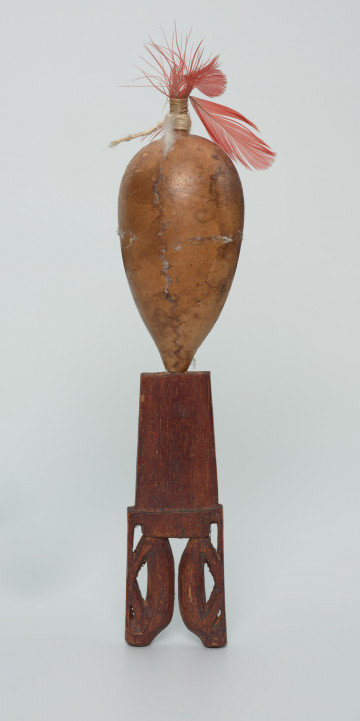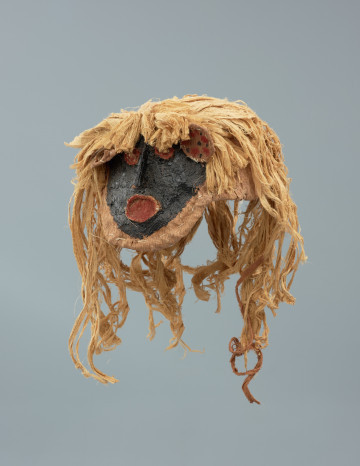
Shaman's maraca, rattle
około 1987
National Museum in Szczecin
Part of the collection: Crafts of the Amazon Indians
The jaguar mask is made from tapa - a raw material extracted from the inner layer of the bark of trees and shrubs softened through a process of soaking and pounding. The Witoto Indians obtain it from the Mauritia palm tree. The bark of this tree is also used to make tipiti, a press used to squeeze out the poisonous prussic acid from bitter cassava, which is the primary source of food for the Indians. Mauritia palm fibre is also used to make ropes, cords, hammocks and nets. Adequately prepared tapa is painted with natural dyes. Ceremonial masks were used during initiation rituals for boys and girls. They usually depict forces of nature, animals and images taken from mythology and Witoto cosmology. The mask comes from the collection of Borys Malkin, an outstanding Polish collector and researcher of Latin American cultures, who in 1960, 1966 and 1970 visitedEstirón, a Witoto Indian village on the Ampiyacu River in Peru. The Witoto are also known in anthropological literature as Huitoto and Uitoto. The basis of their economy is agriculture. They grow bitter and sweet cassava, yams, bananas, maize, palm trees, sugar cane, pineapples, mangoes, cocoa, coca, tobacco and peanuts. They are traditionally divided into clans, tracing their ancestry back to a common ancestor, real or mythical. They used to live in large communal huts with about 100-150 related people. Nowadays, they live in rectangular houses made on stilts, and community huts have ceremonial functions. The existence of a ceremonial house in a settlement depends on a chief who also served as a shaman. The Estirón village chief died a few years before Malkin's arrival, so he no longer found a ceremonial community house in the settlement. The lack of a shaman and the activities of Catholic and Protestant missionaries were responsible for the disappearance of traditional rituals, especially those connected with the production of ceremonial masks and costumes. The Estirón settlement underwent such a robust acculturation process that Malkin's objects and photographic materials are the only evidence of their traditional culture.
Katarzyna Findlik-Gawron
Author / creator
Dimensions
cały obiekt: height: 51,5 cm, width: 27 cm
Creation time / dating
Creation / finding place
Identification number
Location / status

około 1987
National Museum in Szczecin

około 1990 — 2000
National Museum in Szczecin

około 1990 — 2000
National Museum in Szczecin
DISCOVER this TOPIC
Museum of King Jan III's Palace at Wilanów
DISCOVER this PATH
Educational path